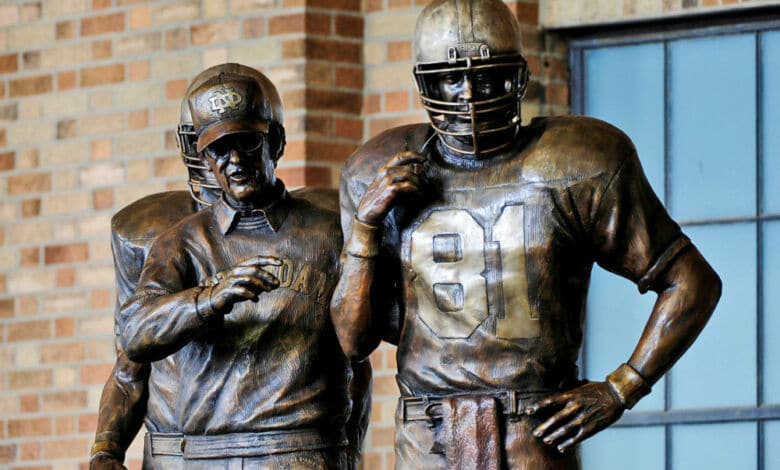
The Lou Holtz era brought more than just a national championship in 1988. It also brought a period of dominance. From 1988 to 1993, his Fighting Irish football program went a combined 64-9-1, with a national championship, two #2 finishes, a #4 finish, and a #6 finish. Over that six-year time frame, his worst finish in the rankings was #13, by the AP in 1991, and even that included a 39-28 victory over #3 Florida in the Sugar Bowl. Perhaps most impressively, Holtz went 12-1 against the top five from 1988-1993. In short, it was a really good time.
Since the end of the 1993 season till the present Kelly-era, it has been a series of false positives for the Notre Dame football program. Included was the fall of Lou and the failures of the Davie, Willingham, and Weis eras. I wanted to look at each coaching regime to dissect where it all went wrong and culminate with the Kelly era and if he can bring the program all the way back.
I’ll naturally start with Lou, who finished his Notre Dame career going 23-11-1 from 1994-1996, with no bowl victories and no top 10 finishes. Where did it suddenly take a turn for the worst?
(This is going to focus on the on-field, football aspects, and less on the politics between the administration and Lou, the change in AD’s, etc., which is beyond my pay grade.)
Losing Tommie Frazier To Nebraska
Lou Holtz and Notre Dame were stunned on national signing day in 1992, when quarterback Tommie Frazier out of Florida signed with Nebraska instead of Notre Dame, even with Holtz visiting Frazier at his home the Friday before signing day.
The following cycle, Notre Dame signed Ron Powlus, predominantly a passer, and the Notre Dame offense lost the quarterback as a weapon in the running game.
Lou started his run of dominance with Tony Rice as his starting quarterback, and he was a runner in the extreme, to say the least. He attempted 137 and 138 passes throughout his two seasons as the starting quarterback, and in his second year, his rushing attempts (174) eclipsed his passing attempts (137) by 37. Rice was the team leader in rushing yards and attempts in 1989 and totaled 23 rushing touchdowns over the span of his Notre Dame career. In his two full seasons as the starter, Rice went 23-1.
When Holtz transitioned to Rick Mirer in 1990, the running game was still emphasized, even if Mirer was less of a running threat. Throughout his four year career, Mirer toted the ball 253 times for 694 yards and 17 touchdowns. Obviously, some of those attempts have sacks included, but the 17 rushing touchdowns are notable, and Mirer ran for a career-high nine in 1991. In his three full seasons as the starter, Mirer finished 29-7-1.
In his one season as a starter, Kevin McDougal ran just 55 times for 85 yards but contributed four touchdowns, and the option was still in his arsenal, as evidenced by his 43-yard touchdown run at Michigan in 1993. He famously finished 11-1 as a starter.
With the addition of Ron Powlus to the starting lineup in 1994, the threat of the run at quarterback vanished for the duration of the Holtz tenure. Powlus finished his Notre Dame career with 235 attempts for -123 yards and three rushing touchdowns. Obviously, the majority of those attempts came on sacks, and the only season he finished with positive rushing yards was 1996, when he registered 53 attempts for 8 yards and no touchdowns.
Unfortunately, this transition to a passing quarterback coincided with a drop in receiver recruiting.
Lack Of Playmaking At Receiver
In 1994 and 1995, it was primarily the Derrick Mayes show at receiver, and it was a show indeed, but there wasn’t enough there to sustain a lethal passing attack that scared the elite programs. Speedy Michael Miller was kicked off the football team mid-season in 1994 after being indicted in Texas, which left the Irish with Charles Stafford and Emmett Mosely as the other receiving threats on the 1994 team. In 1995, Mayes again dominated at receiver, catching 48 passes, with second-leading receiver Emmett Mosley totaling 17 receptions for 268 yards and a score. 1996 is when things took a dive with Mayes out of the program, with Mosley and Malcolm Johnson combining for 49 catches, 818 yards, and two touchdowns.
What crippled the Notre Dame passing game was the loss of signee Randy Moss to the 1995 team after he was denied admission into the University. Clearly, he would have solved Notre Dame’s lack of explosiveness and dependability at receiver.
After seeing Rocket, Tony Smith, Lake Dawson, Mike Miller, and Derrick Mayes drafted into the NFL from 1991-1996, Notre Dame saw one receiver drafted–Malcolm Johnson–from 1997-2002.
Holtz shifted to a more passing oriented attack with Powlus, but could not bring in the receiving talent to compliment that, and the team suffered for it.
The End Of A Huge Run In The Secondary
Notre Dame continued to be lights out defensively in the front seven. Renaldo Wynn, Paul Grasmanis, Melvin Dansby, Bert Berry, Kinnon Tatum, and Kory Minor all enjoyed excellent Notre Dame careers and were top-five caliber.
Where the defense fell off was in the secondary. From 1990-1994, Notre Dame had ten defensive backs drafted, highlighted by first-round picks Todd Lyght, Jeff Burris, and Tom Carter. Bobby Taylor was a second-round pick in 1994, and Pat Terrell was a 2nd round pick in 1990. Those five players totaled 113 NFL career interceptions, In total, the ten drafted brought in 128.
From 1995-2001, Notre Dame saw two players drafted in the secondary, Shawn Wooden in the 6th round and Allen Rossum in the 3rd. Wooden posted five career interceptions, and Rossum was mainly a special teams player as a returner. The talent on the back end just wasn’t there, which hurt them in 1994 against Michigan, BYU, Boston College, and Colorado, in 1995 against Ohio State and Florida State, and 1996 against Ohio State and USC.
Overall
Lou had the one bad season in 1994, but the 1995-1996 teams were as good in many of the key areas they were during their heyday. They were very strong at running back, the offensive lines were well-coached and loaded with talent, the front seven was athletic and aggressive. But, the lack of a threat at quarterback, lack of a dynamic receiver, and weakness in the secondary ultimately kept them from being an elite team. It would have been interesting to see Lou transition to the Jarious Jackson era, who was a cross between Mirer and Rice in terms of style of play.
For the next installment, we’ll look at why Davie failed and the program beginning its slide to mediocrity.
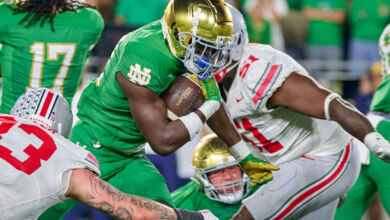
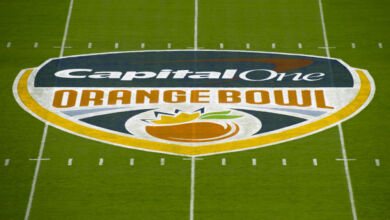
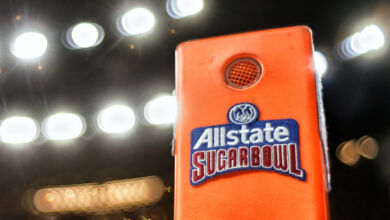
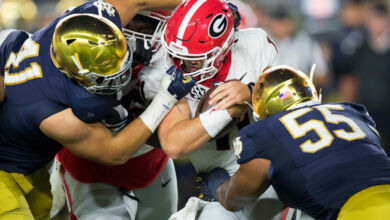

A lot of specific info but hard to follow. I would suggest that it be presented in a more logical, chronological style, still maintaining the heading of specific reasons. But thanks for starting what should be an interesting analysis series of the reasons for our dismay, —– our lower expectations clashing with our high bars of hope. It would be really great, if we could see the shenanigans of the Big Boys in the backroom involving dislike, jealously, personal incompetence, false beliefs that ND could not maintain excellence in both education and football at the same time.